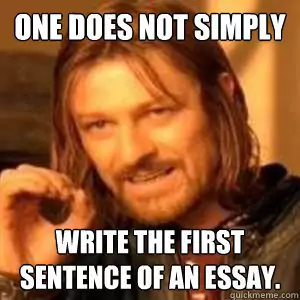 You must have already heard multiple times that the introductory paragraph of almost any piece of writing, be it a college essay or a newspaper article, is important. Why is this so, you might ask? The answer lies in the old and well-known proverb that the first impression is the strongest one. The mission of an introductory paragraph is to catch the reader’s attention, and make them read through the rest of the text with interest. It also includes a crucial part of any piece of writing: a thesis statement or key statement. An introduction also provides background information about the main topic. Hence, knowing how to craft a well-written introduction is an essential skill to obtain.
You must have already heard multiple times that the introductory paragraph of almost any piece of writing, be it a college essay or a newspaper article, is important. Why is this so, you might ask? The answer lies in the old and well-known proverb that the first impression is the strongest one. The mission of an introductory paragraph is to catch the reader’s attention, and make them read through the rest of the text with interest. It also includes a crucial part of any piece of writing: a thesis statement or key statement. An introduction also provides background information about the main topic. Hence, knowing how to craft a well-written introduction is an essential skill to obtain.

JOIN OUR LEARNING HUB
✅ AI Essay Writer ✅ AI Detector ✅ Plagchecker ✅ Paraphraser
✅ Summarizer ✅ Citation Generator
✅ AI Essay Writer ✅ AI Detector ✅ Plagchecker ✅ Paraphraser
✅ Summarizer ✅ Citation Generator
Steps for Writing
- Decide on the scope of the introduction. It may be general at the outset, but narrows down to a thesis statement, or it can be specific from the beginning.
- Decide on the main points you want to cover in your paper, and list them in the following 3-4 sentences of the introduction; one point per sentence is fine. You may want to restate them so that they do not sound exactly the same as in the text.
- Compose your thesis statement. Make it as concrete and specific as you can, as it is the main part of the introduction.
- Double-check everything you have written to make sure you have not missed anything and provided all the necessary background information.
Key Points to Consider
- There are many efficient attention grabbers, so instead of inventing something new, you can choose one that suits your purposes the most. Intriguing examples, provocative questions, puzzling or absurd statements, even intended generalizations about controversial issues, and many other techniques—they all can help you make your introduction catching and engaging.
- The middle sentences of your introduction (usually there are 3-4 such sentences) usually cover the points you analyze in your paper. So, you should either clarify these points for yourself before starting to write your paper, or craft the introduction after you already finish the paper and know exactly what it is about.
- A thesis statement must clearly introduce the main idea of your paper, its core message; it is placed at the end of the introductory paragraph. Usually, a thesis statement is covered only in 1-2 sentences. This is the part you should pay the most attention to when writing the introduction, as without a proper thesis statement, neither your readers nor you will have a clear idea of your paper.
Do and Don’t
Do
|
Don’t
|
Common Mistakes
- Composing an introduction that is too vague or general, which serves no other purpose than matching the word limit.
- Using dictionary definitions in the introduction.
- Providing too much content in the introduction, so that instead of simply preparing readers for what is awaiting them, you start to explain your material or give them excessive information.
- Announcing your intentions about the paper in the introduction.
Follow us on Reddit for more insights and updates.


Comments (0)
Welcome to A*Help comments!
We’re all about debate and discussion at A*Help.
We value the diverse opinions of users, so you may find points of view that you don’t agree with. And that’s cool. However, there are certain things we’re not OK with: attempts to manipulate our data in any way, for example, or the posting of discriminative, offensive, hateful, or disparaging material.
Comments are closed.